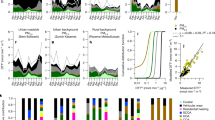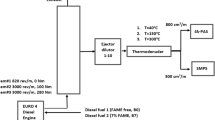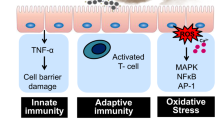Abstract
ALTHOUGH the experimental techniques are available, limited effort has been made to characterize physically and chemically the particulate emissions from air pollution sources with respect to particle size, total surface area and chemical composition, If the potential to affect human health, property or atmospheric reactions or visibility of the particulate pollution, present in urban atmospheres, is to be evaluated, the nature of the contribution from each source will have to be more fully understood than at present. In this study, we focused on the characterization of particulates in a diesel engine exhaust.
This is a preview of subscription content, access via your institution
Access options
Subscribe to this journal
Receive 51 print issues and online access
$199.00 per year
only $3.90 per issue
Buy this article
- Purchase on Springer Link
- Instant access to full article PDF
Prices may be subject to local taxes which are calculated during checkout
Similar content being viewed by others
References
Holtz, J. C., et al., in Diesel Engines Underground, I, Composition of Exhaust Gas from Engines in Proper Mechanical Condition, US Bureau of Mines, R.I., 3508 (1940).
Holtz, J. C., Safety with Mobile Diesel-powered Equipment Underground US Bureau of Mines, R.I., 5616 (1960).
Elliott, M. A., Nebel, G. J., and Rounds, F. G., J. Air Poll. Control Assoc., 5, 103 (Aug. 1955).
McKee, H. C., Clark, J. M., and Wheeler, R. J., J. Air Poll. Control Assoc., 12, 516 (Nov. 1962).
McKee, H. C., McMahon, W. A., and Roberts, L. R., Proc. Semi-ann. Tech. Conf., Air Poll. Control Assoc., 208 (Nov. 1957).
Rounds, F. G., and Pearsall, H. W., Soc. Auto. Eng. J., 65, 60 (June 1957).
Linnell, R. H., and Scott, W. E., J. Air Poll. Control Assoc., 12, 510 (Nov. 1962).
Parker, W. G., and Wolfhard, H. G., J. Chem. Soc., 2038 (1950).
Schalla, B. L., Clark, T. P., and McDonald, G. E., NACA Report 1186 (1954).
Schalla, B. L., and Hibbard, R. R., NACA Report, 1300 (1957).
Meurer, J. S., “Evaluation of Reaction Kinetics Eliminates Diesel Knock”, Soc. Auto. Eng. Trans., 64, 250 (1956).
Howe, W. A., Soc. Auto. Eng. Paper No. 631, 17 (1956).
Gross-Gronomski, L., Auto. Eng., 531 (Dec. 1964).
Encyclopedia of Instrumentation for Industrial Hygiene (edit. by Yaffee, C. D., Byers, D. H., and Hosey, A. D.), 203 (Univ. Michigan Inst. Indust. Health, Ann Arbor, Mich., 1956).
Brunauer, S., Emmett, P. H., and Teller, E., J. Amer. Chem. Soc., 60, 309 (1938).
Faeth, P. A., in Adsorption and Vacuum Technique (Univ. Michigan Inst. Sci. Tech., 1962).
Junge, C. E., in Air Chemistry and Radioactivity, 118 (Academic Press, New York, 1963).
Battigelli, M. C., et al., Terminal Report USPHS—Dose-Response Relations from Inhalation of Diesel Exhaust, Univ. Pittsburgh (1967).
Author information
Authors and Affiliations
Rights and permissions
About this article
Cite this article
FREY, J., CORN, M. Diesel Exhaust Particulates. Nature 216, 615–616 (1967). https://doi.org/10.1038/216615a0
Received:
Revised:
Published:
Issue Date:
DOI: https://doi.org/10.1038/216615a0
This article is cited by
-
A collection of the best practice examples of electroanalytical applications in education: from polarography to sensors
Journal of Solid State Electrochemistry (2024)
-
Die Wasserbenetzbarkeit von Blattoberfl�chen und ihre submikroskopische Wachsstruktur
Planta (1971)
Comments
By submitting a comment you agree to abide by our Terms and Community Guidelines. If you find something abusive or that does not comply with our terms or guidelines please flag it as inappropriate.



